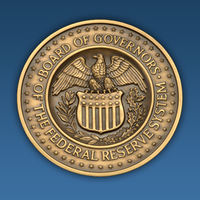The Fed's Balancing Act: Navigating Stagflation and Global Tensions
June 19, 2025, 5:11 pm

Location: United States, Michigan, Ann Arbor
Employees: 10001+
Founded date: 1817
Total raised: $5.2M
The U.S. economy is walking a tightrope. The Federal Reserve has decided to keep interest rates steady, hovering between 4.25% and 4.5%. This decision reflects a cautious approach amid swirling economic uncertainties. The Fed is eyeing potential interest rate cuts later in 2025, but the road ahead is anything but clear.
Inflation is a looming specter. The Fed predicts it will surpass 3% in 2025, a significant jump from earlier forecasts. This inflation is measured by the personal consumption expenditures price index, a key indicator of consumer prices. The central bank's updated outlook paints a picture of a slowing economy, with growth expected to dip to 1.4% this year, down from a previous estimate of 1.7%. The term "stagflation" is creeping into conversations, a toxic mix of rising prices and stagnant growth.
Recent economic data offers a glimmer of hope. In May, the U.S. added 139,000 jobs, and the unemployment rate held steady at 4.2%. Consumer sentiment is on the rise, suggesting that Americans are feeling more optimistic. Yet, this optimism may be a mirage, fueled by the delayed effects of tariffs. The Fed's Chair, Jerome Powell, emphasized that tariffs take time to ripple through the economy. Goods sold today may have been imported months ago, before tariffs were imposed. The true impact of these tariffs is yet to be fully realized.
Powell acknowledged that while the economy appears stable now, it will inevitably slow. The Fed is preparing for a potential downturn, and the specter of stagflation looms large. Market watchers are tuning into this new reality, as the catchy tune "I Got Summer on My Mind" morphs into "I Got Stagflation on My Mind."
In the stock market, U.S. indices are treading water. The S&P 500 and Dow Jones Industrial Average showed minimal movement, while the Nasdaq Composite inched up slightly. Oil prices are also flat, reflecting a broader sense of uncertainty. Across the Atlantic, Europe’s Stoxx 600 index fell, indicating that global markets are feeling the pressure.
The geopolitical landscape adds another layer of complexity. President Donald Trump is wrestling with decisions regarding Iran. He has yet to determine whether to order military strikes, a choice that could have profound implications for global oil markets. The potential for regime change in Iran, whether through U.S. or Israeli action, could send shockwaves through oil prices, according to JPMorgan.
As tensions simmer in the Middle East, the Fed's focus remains on domestic economic indicators. Powell highlighted the impact of tariffs on consumer prices, warning that the burden will eventually fall on the end consumer. The Fed's forecasts suggest that inflation will rise, driven by these tariffs. The economy may seem resilient now, but the slow burn of tariffs could ignite inflationary pressures in the coming months.
The Fed's cautious stance is mirrored in the broader market sentiment. Institutional investors are increasingly looking to emerging markets, despite the challenges posed by tariffs. The Bank of America’s Fund Manager Survey indicates a growing enthusiasm for these markets, suggesting that investors are seeking opportunities beyond U.S. borders.
However, the U.S. and European Union are facing their own trade hurdles. Negotiations on tariffs are stalling, with both sides struggling to find common ground. The temporary cuts on duties are set to expire soon, and without a deal, reciprocal tariffs could soar to 50%. Trump has expressed frustration with the negotiations, stating that he doesn’t feel a fair deal is on the table.
The stakes are high. A failure to reach an agreement could disrupt trade worth nearly $2 trillion. The relationship between the U.S. and EU is critical, and both sides must navigate these negotiations carefully to avoid a trade war.
In summary, the U.S. economy is at a crossroads. The Federal Reserve is balancing the need to manage inflation while supporting growth. The specter of stagflation looms, and geopolitical tensions add to the uncertainty. As markets remain flat and negotiations stall, the path forward is fraught with challenges. The Fed's decisions will be pivotal in shaping the economic landscape in the months to come. The tightrope walk continues, and all eyes are on the Fed as it navigates these turbulent waters.
Inflation is a looming specter. The Fed predicts it will surpass 3% in 2025, a significant jump from earlier forecasts. This inflation is measured by the personal consumption expenditures price index, a key indicator of consumer prices. The central bank's updated outlook paints a picture of a slowing economy, with growth expected to dip to 1.4% this year, down from a previous estimate of 1.7%. The term "stagflation" is creeping into conversations, a toxic mix of rising prices and stagnant growth.
Recent economic data offers a glimmer of hope. In May, the U.S. added 139,000 jobs, and the unemployment rate held steady at 4.2%. Consumer sentiment is on the rise, suggesting that Americans are feeling more optimistic. Yet, this optimism may be a mirage, fueled by the delayed effects of tariffs. The Fed's Chair, Jerome Powell, emphasized that tariffs take time to ripple through the economy. Goods sold today may have been imported months ago, before tariffs were imposed. The true impact of these tariffs is yet to be fully realized.
Powell acknowledged that while the economy appears stable now, it will inevitably slow. The Fed is preparing for a potential downturn, and the specter of stagflation looms large. Market watchers are tuning into this new reality, as the catchy tune "I Got Summer on My Mind" morphs into "I Got Stagflation on My Mind."
In the stock market, U.S. indices are treading water. The S&P 500 and Dow Jones Industrial Average showed minimal movement, while the Nasdaq Composite inched up slightly. Oil prices are also flat, reflecting a broader sense of uncertainty. Across the Atlantic, Europe’s Stoxx 600 index fell, indicating that global markets are feeling the pressure.
The geopolitical landscape adds another layer of complexity. President Donald Trump is wrestling with decisions regarding Iran. He has yet to determine whether to order military strikes, a choice that could have profound implications for global oil markets. The potential for regime change in Iran, whether through U.S. or Israeli action, could send shockwaves through oil prices, according to JPMorgan.
As tensions simmer in the Middle East, the Fed's focus remains on domestic economic indicators. Powell highlighted the impact of tariffs on consumer prices, warning that the burden will eventually fall on the end consumer. The Fed's forecasts suggest that inflation will rise, driven by these tariffs. The economy may seem resilient now, but the slow burn of tariffs could ignite inflationary pressures in the coming months.
The Fed's cautious stance is mirrored in the broader market sentiment. Institutional investors are increasingly looking to emerging markets, despite the challenges posed by tariffs. The Bank of America’s Fund Manager Survey indicates a growing enthusiasm for these markets, suggesting that investors are seeking opportunities beyond U.S. borders.
However, the U.S. and European Union are facing their own trade hurdles. Negotiations on tariffs are stalling, with both sides struggling to find common ground. The temporary cuts on duties are set to expire soon, and without a deal, reciprocal tariffs could soar to 50%. Trump has expressed frustration with the negotiations, stating that he doesn’t feel a fair deal is on the table.
The stakes are high. A failure to reach an agreement could disrupt trade worth nearly $2 trillion. The relationship between the U.S. and EU is critical, and both sides must navigate these negotiations carefully to avoid a trade war.
In summary, the U.S. economy is at a crossroads. The Federal Reserve is balancing the need to manage inflation while supporting growth. The specter of stagflation looms, and geopolitical tensions add to the uncertainty. As markets remain flat and negotiations stall, the path forward is fraught with challenges. The Fed's decisions will be pivotal in shaping the economic landscape in the months to come. The tightrope walk continues, and all eyes are on the Fed as it navigates these turbulent waters.


